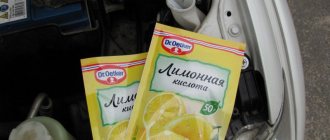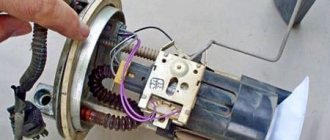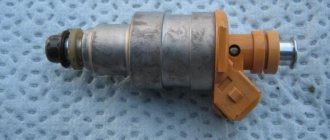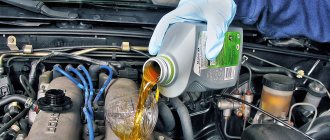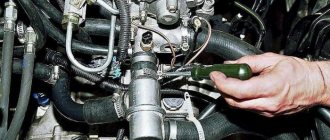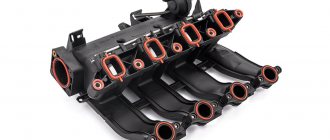Is the washer reservoir frozen? Warm up immediately!
Heat the whole car
The easiest way is to warm up the entire car. How can this be organized? There are three options:
- Drive the car into a warm parking lot, for example, in the basement of a shopping center.
- Warm up in a warm box.
- Visit a car wash and reserve a full package of services. External and internal washing with finishing work in the form of polishing plastic panels and applying wax to the body takes a lot of time, which may be enough to defrost the windshield washer.
The main disadvantage of complex heating is the large amount of time spent on defrosting. It will take about a day for the water to thaw if the car is placed in an underground parking lot. Things are more cheerful when I grabbed a demi-season anti-freeze, but still...
Heat the tank only
An excellent alternative to complex heating is defrosting only the washer tank. A failsafe option: remove the tank and take it home under a stream of lukewarm, and then hot water. The ice will quickly turn into liquid and the container can be emptied. Just don’t direct a hot jet at a cold part - it will crack instantly.
With the advent of powerful construction hair dryers, it became possible to heat the tank together with the pipelines. The method is good, but requires extreme caution and the presence of a 220 V outlet near the car.
What if the tank is under the bumper?
Everything would be fine, but the layout of the engine compartment does not always allow easy access to the windshield washer system reservoir. This is on Vesta, Logan, Duster, the reservoir is in the free access zone. But what about the owners of Kia Rio, Hyundai Solaris and other foreign cars, under the hood of which you can only see a neck with a blue cap.
Our colleagues from the magazine “Behind the Wheel” urge you to discard the idea of labor-intensive dismantling of the tank. Instead, the well-known editors proposed a very interesting method:
- Heat a good anti-freeze solution or a concentrate diluted to the minimum temperature in a water bath.
- Pour the heated mixture into the frozen container.
- Mix the liquid in the tank using a tire compressor for 2-3 minutes.
- Drain the cooled washer fluid from the reservoir into a container using the old-fashioned method of draining gasoline from the fuel tank. Insert the hose into the tank, create a vacuum in it and direct the stream into a container located obviously below the frozen tank.
“Zarulevtsy” insist on repeating the described procedures until the windshield washer system is completely defrosted.
At the same time, it would be nice for the engine to be thoroughly warmed up and running: extraneous heat will speed up the defrosting of the windshield washer. The proposed method is good. Including because it is adapted to non-standard conditions. So, far from civilization, a canister of anti-freeze can be heated directly on the engine. Yes, it will take almost 20-30 minutes to boil a five-liter bottle, but still... Disadvantages - the tank must be half empty, the temperature difference is insignificant so that the tank does not crack.
Is the water in the windshield washer reservoir frozen? Chemistry is in effect!
If there is no heat nearby, then you can use tricks from a school chemistry course. Each of us has probably heard about exothermic and endothermic reactions. So, all methods of defrosting of chemical origin are based on the interaction of alcohol with water. A reaction at a sufficiently high concentration of alcohol falls under the definition of exothermic, that is, one that occurs with the release of heat.
The theoretical basis is clear, but what about practice? What exactly should you pour into a frozen tank? There are three options:
- Vodka or pure ethyl alcohol. In order to reduce concentration and speed up the process, the liquid can be heated directly on the engine.
- Concentrate for making antifreeze. The recipe for use is similar to Zarulev’s - only we heat not the concentrated mixture, but water/anti-freeze. So, pour the heated water into the tank, followed by the maximum amount of concentrate. The engine is warmed up and running.
- Lock defroster. Disconnect the motor and inject the product into the hose and tank. The remedy, it must be admitted, is ineffective in these conditions. More suitable for defrosting straws.
The negative aspects of chemical methods are obvious: it is completely pointless to pour anything into an overfilled tank.
Generally speaking, a fully filled tank will only thaw when it is warmed up or the entire machine is warmed up. As a word of advice, take note of the following: even high-quality composition freezes at temperatures below -25°C. If you are not sure about the quality, then check out homemade recipes that will allow you to make anti-freeze in the washer yourself and be sure of its condition.
Why did the water in the tank freeze?
With the onset of cold weather, every driver must take care of his car. First of all, you need to drain the regular water from the washer and fill it with antifreeze liquid. If this is not done, then as soon as frost sets in, you will have to spend time defrosting the tank. If the antifreeze has turned into ice, then there may be two reasons:
- You didn't drain the water properly. If you mix a small amount with anti-freeze, there is an 80% chance that the liquid will turn into ice.
- Low quality non-freezing liquid. Automotive fluid manufacturers often cheat and dilute their washer fluids with water.
According to the Rules of Regulation, the driver has no right to drive with a faulty car. A frozen washer reservoir is one of the cases where you will be fined.
Tips for defrosting the tank
Most motorists are deprived of the opportunity to leave their car in warm parking lots and personal garages. The average driver leaves his vehicle next to his house, on the street. In the morning, in winter, when the temperature has dropped sharply, a number of problems arise: the car will not start, the glass is frozen, the washer reservoir is filled with ice. There are a number of ways to deal with the latter problem.
Hot water
The simplest and most effective way is to pour hot water into the tank. Take into account several nuances. Never pour boiling water into a plastic container. This will cause the container to deform and may lead to cracking due to temperature differences. The injected stream should not exceed 50°C. In this case, the level in the container should not exceed one third. After pouring the required amount, you will have to wait 15-20 minutes for the heat to melt the liquid in the tubes and nozzles a little.
Warm anti-freeze
An alternative to warm water is heated antifreeze liquid. Heat the washer fluid to 50°C so as not to damage the reservoir, as in the previous case. If you don’t want to go up to your apartment, pour anti-freeze into a bottle and put it on the motor. After twenty minutes, the liquid will be warmed up.
Winter concentrate
If you don’t want to bother with heating the anti-freeze water, buy a special winter concentrate and pour it into the frozen washer container. By pouring the concentrate into the tank, it will provoke a reaction and after a while will completely melt the formed ice. It is recommended to fill in winter liquid at the end of October, when the temperature outside begins to drop.
Liquids containing alcohol
There is not always a store near your house where you can buy anti-freeze liquid. In this case, a life hack with vodka, alcohol, and cologne will help out. Take 300 ml of any liquid, heat it to +50°C and pour it into the frozen system. The effect will appear after some time and will persist until the liquid runs out. Alcohol-containing products tend not to freeze in the cold, but using them as a washer is expensive. If there is no alternative, then this method has a place.
Salty water
A great way to melt ice is with a saline solution. But it is worth remembering that when interacting with metal, salt causes corrosion. You can use this method one time only. To prepare the saline solution, take 5 tbsp. salt and a liter of water at room temperature. Pour the resulting mixture into the tank, after 20 minutes the washer should completely melt.
Inexperienced drivers use the services of specialists who come to the call and warm up the car using a heat gun. The service includes replacing water with non-freezing liquid.
What to do if the washer fluid freezes?
If the water in the washer reservoir is frozen, then the car owner has several ways to solve the problem. The time it takes to empty the container depends on how you remove the ice and the ambient temperature. The basic method of warming up is to place the car in a warm garage or underground parking for several hours. The advantage of this method is the defrosting of the liquid in the tank and in the water supply lines to the nozzles.
After complete heating, the water is drained from the system using a standard pump; to speed up the process, you can remove the tube from the tee that distributes the liquid between the sprayers. The end of the line is lowered into the container, the pump drains 4-5 liters of liquid within 1 minute. Then you should replace the removed tubes and fill the container with an antifreeze compound. Then the driver needs to press the steering column washer lever several times, which will remove the remaining water from the lines and nozzle cavities.
Warm up with hot water
Water at elevated temperatures can be used to melt the ice in the tank. The technique is used in cases where the tank is filled with frozen liquid by 25-30%. It is strictly prohibited to pour boiling water, as there is a risk of deformation of the container. In severe frosts, you can warm up the tank by filling it with non-freezing liquid at a temperature of 50-60°C. After the ice has melted, the mixture is drained into a separate container or onto the ground.
The disadvantage of the technique is the preservation of frozen water in the lines and nozzles of the sprayer. The lines are heated using heat from a running engine; the nozzles can be cleaned by heating the body with your fingers.
Hairdryer to the rescue
The method is used when the tank is completely filled with ice, when pouring hot water does not have a positive effect. Before starting the procedure, it is recommended to warm up the engine and engine compartment, which will reduce the defrosting time and protect the paintwork of the engine compartment from cracking due to temperature changes. Then you should run power wires to the parking lot to connect a hair dryer.
- Plug in the hair dryer and begin gently warming up the tank body. The supply of excessively hot air leads to destruction or deformation of the housing.
- As the liquid warms up, it can be pumped out using a rubber bulb with an extension tube.
- After removing the ice from the tank, fill in the antifreeze compound, and then carefully warm up the lines and nozzles.
- Check the functionality of the window washer system.
Antifreeze or alcohol-containing liquid
You can quickly defrost the water in the washer reservoir using an alcohol-based anti-freeze substance:
- Heat a small volume of antifreeze composition to a temperature of +25. +30“С.
- Pour the substance into the washer container up to the top edge of the neck and wait a few minutes. As the ice melts, the fill level begins to decrease because frozen water takes up more volume than liquid water.
- Add the next portion of warm antifreeze. To speed up the process, the melted mixture is pumped out of the tank, which is done with a rubber bulb or a 40-50 cm³ syringe with an extension tip.
- Repeat the procedure of pouring fresh anti-freeze until the ice is completely removed from the tank cavity. The remaining mixture of liquids should be removed, since it has a high crystallization temperature and will turn into ice during the next frost.
- Fill the system with clean antifreeze. Removal of ice residues from the lines and injectors occurs gradually, due to the heating of the parts with heat from the engine. Accelerated cleaning of the tubes using a hairdryer is allowed (subject to safety precautions).
In the absence of a special anti-freeze liquid, you can use solutions with a high content of ethyl alcohol (for example, vodka).
If industrial or medical alcohol is used, then preheating is not required, since when water and alcohol are mixed, the temperature of the solution increases.
Warm up the engine
Step-by-step instructions for warming up:
- Place the car in a ventilated area to prevent exhaust gases from entering the cabin.
- Cover the hood and radiator with thick plastic film, tarpaulin or other material. This ensures enhanced heating of the engine compartment.
- Start the power unit and warm it up to operating temperature. When the cooling system fan is activated, increased circulation of hot air occurs in the engine compartment, ensuring accelerated heating of the tank.
- Stop the engine and wait 5-10 minutes, then check the condition of the fluid in the windshield washer reservoir. If ice is detected, the procedure should be repeated.
- After complete heating, drain the water and fill the tank with antifreeze liquid.
- This technique allows you to melt the ice only in the tank itself and in the tubes located on the hood. Some of the lines and nozzles located on the ventilation frill remain clogged with frozen water. To warm up, use a hairdryer or place the car in a warm room. It is also possible to use a special liquid to remove ice from the lock cylinders, which is carefully sprayed inside the nozzle.
How to quickly defrost water in the windshield washer reservoir
Every real driver looks forward to the onset of winter, preparing for it in every possible way. Some change the battery, some change the spark plugs, some change the antifreeze, and almost everything - engine oil and tires, and some do everything at once. And this is correct, because most of us live in a climate zone with fairly severe winter weather; it would be naive to expect that winter will pass by this year.
Let's imagine the morning of some ordinary driver who diligently prepared for winter, replacing all the necessary consumables before it, spending a sufficient amount of effort and time on this. And finally, waking up in the morning, he notes, not without pleasure, that the X-hour has come! The first, uncertain, but very slippery snow lies on the ground, and the car is a small snowdrift with ice on all the windows at once. Quietly laughing at those who drive out of the yard “half-sideways” without having time to “change their shoes” from summer tires to winter ones, and at those who did not change the dying battery for a new one, and are now jumping from car to car asking “let me light a cigarette, just wires” no,” our hero approaches his own car, ideally prepared for winter, triumphantly turns the key in the ignition, and, with an air of complete superiority, begins to sweep away snow from the roof of the rumbling car with a specially prepared brush. Having shaken off the snow, the driver gets behind the wheel and drives out of the yard on slippery asphalt on winter tires without any problems, smiling and catching the envious glances of those who couldn’t start and those for whom the slightest uphill climb on summer tires gives them a headache.
Having reached the road, our hero discovers that the weather is not yet so cold that all the dirt has frozen. On the contrary, it, lifted by the wheels of passing cars, hangs in the air in the form of a fine dirty fog that instantly envelops the windshield. But is this a reason for frustration if there are winter (or frameless) wipers?! Not at all! The driver boldly and fearlessly throws them into the battle to keep the glass clean, but after a few moments they only smear the dirt. “It’s no problem,” our hero thinks to himself, “now we’ll help them with some water,” with these thoughts he pulls the lever for supplying water from the washers to the windshield, and here comes the moment of truth. Most often, nothing happens at this second - no water flows anywhere! What's the matter? And the fact, dear ones, is that our hero, like most other drivers, forgot to fill the washer reservoir with anti-freeze liquid, and all the water in the washer reservoir froze and does not flow into the nozzles on the hood!
What to do in this case? From now on, we will no longer talk about our “virtual” driver friend, and will move on to practical solutions.
So, the first thing to consider is how much water was in the tank. If it is full to the brim, there is ONLY one way out - go to a warm room (for example, a car service center or car wash) and wait until the ice melts. If this is not done at all, then the chances of thawing remain only with the possibility of a thaw, and since winter is just beginning, a thaw may not happen soon. Next, as soon as the system has thawed, try to expel the maximum amount out through the glass washers, and then pour anti-freeze liquid into the system, which you will use until the end of winter.
The advantages of this method are harmlessness to the system and enormous reliability. If something freezes at -2, then it will probably thaw at +20. This is the easiest method for any degree of fullness of the tank.
The disadvantages of this method are wasted time and wasted money. To be honest, there are very few service centers or car washes that will agree to let you warm up for free. Especially when you consider that you will stand in it for at least 15-20 minutes.
However, most often, there is no time for complete defrosting (you have to go!), and the washer reservoir is also not completely filled. In this case, hot water will help you. The easiest way to take it is clear where - in your own home, from which you are most likely not far away. The procedure will be as follows. You will need about one liter of hot water (preferably not boiling water, since a sudden change in temperature can cause the tank to burst), which will need to be poured into the filler neck. Do not touch the system for 1-2 minutes - let the water defrost the ice in the tank, and then try to apply water to the glass.
But this method also has a small pitfall - the fact is that water can freeze not only in the tank itself, but also in the tubes supplying water to the washer nozzles, and in the nozzles themselves, by the way, too. If the water in the tank, resulting from mixing the hot water you poured in and the melted ice, has a sufficient temperature, it can easily break through the ice plugs. As a rule, this happens on the first day of frost, when the air temperature has not dropped far below zero. If the water has found its way and the system is working, you will need to take two more important steps. First, it will be necessary to expel the maximum amount of ordinary water from the system. And secondly, buy an “anti-freeze” at the nearest auto store and replace the water in the tank with it.
The advantages of this method: fast and free defrosting.
Cons - it may not help due to freezing of water in the tubes and spray nozzles; If the method does not help, an additional liter of liquid will appear in the washer reservoir, which will freeze in the near future.
In any case, if the system does not work after washing with hot water, no one forbids you to go into a warm room to warm up.
What to do if the fuel pump freezes
If you use low quality fuel, there may be a problem with the fuel pump freezing. It can occur on both injection and carburetor engines. If such a problem occurs, you will need to remove the fuel pump and warm it up:
Injector.
Injection engines use an electric fuel pump, and most often when it freezes, the fuel supply pipe to the line and the filter ice up. This element is installed directly into the tank, which makes the process of dismantling the fuel pump in order to heat it very difficult. Having removed the fuel pump, you need to warm it up, and then remove the accumulated moisture from it using a can of compressed air. Some fuel pumps for injection engines have the ability to replace the filter; if it is present, change it;- Carburetor. In carburetor engines, the fuel pump is mechanical, and it consists of two parts, between which there is a membrane for filtering the incoming fuel. If water ends up in the fuel pump of a carburetor engine, it will accumulate over time and then risk entering the engine along with the gasoline. At low ambient temperatures, it can freeze in the fuel pump, preventing the passage of gasoline.
If the fuel pump in a carburetor engine is frozen, you can simply dismantle it and warm it up, after which you need to drain the accumulated water from it using the manual pumping lever. It is also necessary, after warming up the part, to remove the filter from it and dry it, and then install it back.
Water getting into the fuel pump can negatively affect engine performance even in warm weather, so it is important not only to warm up the fuel pump, but also to carry out the procedures described above to remove water.
If water freezes in the engine: what should the driver do?
As you know, the cooling system of a modern engine is a combined liquid and air cooling system. The liquid cooling system of an internal combustion engine contains working fluid. For a long time, such a working fluid was ordinary running water, which was widely used in various types of civil, commercial and other transport. The use of water allowed for sufficient heat removal and ensured an acceptable service life of the cooling system elements.
We also recommend reading the article about the design and operating principles of the engine cooling system. From this article you will learn about the various structural elements of this system and other features.
At the same time, the main disadvantage of using water in the cooling system was and remains the difficulties that drivers encounter when operating a car in the cold season. We add that although the active development of the chemical industry made it possible to subsequently offer an alternative in the form of antifreeze or antifreeze, some drivers continue to use running or distilled water today. The reason for this decision is simple - there is no need to spend money on antifreeze or antifreeze. At the same time, such savings today seem very doubtful for a number of reasons. Next we will talk about what happens if the water in the engine freezes, as well as what the driver should do if the water in the radiator and engine freezes.
Useful tips
In the event that the water in the lower pipeline has not turned into ice, it will be sufficient to implement high-quality insulation of the radiator and the engine itself. Then the water pump is warmed up, after which the unit is started and the engine is allowed to idle for some time. Next, the engine should be immediately turned off at the moment when the water begins to boil.
We can talk about normalizing the circulation of liquid in the cooling system when the heating of the radiator of the cooling system is uniform, that is, its lower part is also warmed up. After starting the engine and resuming water circulation in the system, it is recommended to warm up the power unit until it reaches operating temperatures or close to those at idle, then carry out an inspection. If no leaks or other defects in the cooling system are found, then you can load the unit, that is, start moving. In this case, it is recommended to carefully monitor the temperature of the internal combustion engine, since freezing of water in the cooling system often leads to undesirable consequences.
Finally, we would like to add that using even the cheapest antifreeze or antifreeze is a much more justified solution compared to pouring ordinary or distilled water into the system. The fact is that, in addition to freezing in the cold season, water is also unable to protect the parts of the cooling system from corrosion and scale. As a result, the service life of the cooling radiator and heater radiator, pump, thermostat and other elements is significantly reduced. If water is used in loaded modes, the engine may overheat, which affects the quality and stability of its operation, fuel consumption and overall engine life.
The water in the engine froze: causes and consequences
As you know, water tends to freeze. This happens not even at negative temperatures, but at 0 degrees Celsius. It turns out that the answer to the question at what temperature the water in the engine freezes is precisely this mark. Freezing of water leads to crystallization and increase in volume. Please note that in the engine cooling system, the liquid is in a closed circuit.
It becomes clear that freezing will lead to expansion, as a result of which cracks appear in the cylinder block, cylinder head, radiator of the cooling system and other elements.
In simple terms, if the water in the engine block freezes, then the cooling system channels may simply rupture. As a result, the engine will need to be repaired or completely replaced. If the risk of water freezing is not eliminated in a timely manner, damage will also affect the radiator tubes, defects in connecting pipes may appear, etc.
Let us add that the water will not necessarily freeze in the engine immediately when the temperature drops to zero. For complete freezing, the car must be parked in an open parking lot at zero temperature for a certain time (24 hours or more). If the temperature drops even further, then the freezing process can accelerate significantly. It is for this reason that before the advent of antifreeze, drivers were forced to drain water from the engine before winter parking, after which warm water was re-filled into the system before the trip.
We also recommend reading the article about which is better, antifreeze or antifreeze. From this article you will learn about the main differences, advantages and disadvantages of these types of fluids for the engine cooling system.
An additional way to prevent rapid freezing of water is to insulate the radiator and engine. Typically, this solution allows you not to drain the water from the internal combustion engine in winter, taking into account short periods of parking, since the insulation allows you to slow down the cooling process of a heated engine.
ZMZ-406/WATER FROZEN IN THE COOLING SYSTEM - GAZ Volga Community on DRIVE2
Good evening comrades, there is no need to kick and say that this is not done, I understand everything myself. In general, the car was in the garage for repairs, the garage is unheated, there are no available means in the form of infrared lamps and heat guns, and, in principle, there is no time to wait until it warms up. It's been -10 outside for the third day now. Of course, in the garage it’s about -5 -8. The remnants of the flowing water after flushing the engine remained in the system, the reservoir and everything else were empty at the beginning of the frost, if there is water in the radiator, it is at the lower level, about 5-10 cm from the bottom of the radiator. the pump and hoses leading from the bottom of the radiator to the pump and from the cylinder head were frozen. Some of the water, of course, remained in the cylinder head itself. And yes, icicles do not stick out from the engine, the hoses are not swollen. What was done yesterday - I poured antifreeze into the system, about 1 reservoir went straight into the system, and another whole one was filled to the level, in It didn’t go away within 10 minutes, I left the coolant reservoir cap slightly unscrewed. This evening I’ll go see if the fluid has gone from the reservoir into the system, but something tells me that if it has gone, it’s only a little. In general, the question is simple, what should be done first? Personally, I’m inclined to the option: 1) remove the belt from the pump and without fanaticism at speed 800-1000 warm up the engine for about five minutes, monitoring its behavior, while opening the coolant drain valve in the cylinder block, the engine gradually warming up evenly should essentially melt the ice, or part of it, and water will begin to flow out of the tap, repeat if necessary again without fanaticism? Otherwise, I’ve read a lot on the forums and all they advise is to save up for a new cylinder head. 2) fit a friend’s second car to the radiator grill of my car and raise the temperature under the hood with exhaust gases? Yes, there will be a boyd under the hood later, but I was going to wash the engine later anyway. Can you recommend more radical options? How scary is this phenomenon on 406 engines? Or do they, almost like 402, don’t care about everything?
How to defrost an engine if the water is frozen
- Let's start with the fact that water is usually used by owners of fairly old cars. In this case, the primary sign of freezing is usually ice in the expansion tank. If possible, in such a case it is better not to start the car. The fact is that when trying to start, the risk of damage to the pump impeller increases significantly. In this case, it is optimal to tow the car to a heated room, warm box or garage. Next, natural warming will occur, after which the water needs to be drained and diagnostics carried out. If no problems are identified, then all that remains is to flush the system and add antifreeze. This method is considered the most correct and rational.
- If this is not possible, then first you should check the degree of freezing, since ice in the tank does not always mean that the water in the cooling system is completely frozen. Many car enthusiasts recommend this method, when the drive is removed from the pump, after which the engine is started for a few minutes (no more than 5). In this case, there will be no circulation of liquid in the cooling jacket, but the power unit does not have time to overheat. Next, the engine should be turned off, paused for a few minutes and started again for 5 minutes. Several such approaches will be enough for the ice in the system to thaw. Additionally, you can insulate the engine and radiator before the first start. It is also necessary to warm up the pump before starting. To do this, the pump is wrapped in rags, which are poured with hot water. The disadvantage of this method is that on many cars the pump is driven by the timing belt, that is, removing the belt and then starting the engine will not work. In this case, the car must be warmed up in a warm box.
- If the driver started the engine, but there is a suspicion of frozen water in the radiator, then the degree of freezing of the water in the engine can also be determined using a thermometer or as a result of the appearance of steam that comes from the steam outlet tube. This will appear after the engine has started and warmed up for a certain period of time. The fact is that after freezing, a plug of ice is created in the lower part of the radiator. As a result, the water stops its normal circulation in the system and boils after heating. Another sign of an ice jam is the temperature difference in the lower, middle and upper parts of the radiator. The bottom and middle parts will be cold, while the top will be very hot.
- Freezing of water in the lower pipeline is detected tactilely and visually. To do this, just feel the connecting hose, and also open the drain valve and make sure that there is no water escaping. In such a situation, you will need to defrost the ice in the pipeline, as well as in the lower part of the radiator. This is done using rags and hot water. The pipeline and the lower part of the radiator are covered with rags, onto which hot water is poured. The radiator must be heated from the side where the engine cooling jacket pipeline is connected to it. Another auxiliary method is to put a piece of rubber hose on the lower end of the steam outlet tube, after which the escaping stream of steam should be directed to the pipeline and the lower part of the radiator.
The water in the radiator is frozen! How to get out of a situation with minimal losses
Avtoexpert.pro > News > Water has frozen in the radiator! How to get out of a situation with minimal losses
Freezing of water or low-quality coolant in the radiator almost completely paralyzes the operation of the cooling system. You cannot operate a vehicle like this. However, you can defrost ice without leaving the car in a heated room for a long time. How to do it?
Defrosting the radiator
The first priority of a car owner when ice is detected in the radiator is to check the condition of the coolant in the engine jacket. To do this, unscrew the screw closing the drain hole (located on the cylinder block) a few turns. If there is no leakage of liquid from the hole, it means that water has frozen in the engine, which is a direct indication for transporting the car to a warm room, defrosting it and thoroughly diagnosing the condition of the cylinder block. In this case, you cannot start the engine. If coolant leaks from under the screw, the situation allows you to defrost the radiator on the spot. To do this, start and warm up the engine, allowing the coolant to circulate in a small circle. After the temperature of the power unit rises to 40-50 degrees, it is necessary to connect the cooling fan directly to the battery, changing the polarity. The fan will begin to rotate in the opposite direction, moving warm air from the engine to the frozen radiator. In this case, the hood must be closed, helping to create a thermal zone under it. During the procedure, it is necessary to constantly monitor the engine temperature. Exceeding normal heating levels can cause serious technical malfunctions. To prevent them, you can temporarily switch the fan to normal operation before defrosting is completed.
Eliminating the consequences of liquid freezing in the radiator
It is known that frozen liquid expands, deforming and breaking the vessel in which it is placed. The cooling radiator is also susceptible to this effect. Often, after defrosting, cracks are found in it, through which coolant leaks. Large cracks cannot be repaired. The radiator needs to be replaced. However, if there are minor damages, it can be repaired. So, one of the repair methods is to solder the damaged part. It must be soldered while the liquid is cooling, when the pressure in the system becomes close to atmospheric. In this case, liquid leakage, as a rule, does not occur. The soldering area requires additional heating due to the high heat capacity of the radiator. A temporary repair that allows you to get into your home involves sealing the crack with epoxy or fiberglass. Before the procedure, the repair area must be treated with sandpaper and thoroughly degreased. You can operate the car a few hours after applying the epoxy composition.
Ratings: 1 — Rating: 5.00 Loading.
The water in the engine is frozen: what to do?
Author: premierautos · Published 08/04/2011 · Updated 07/29/2018
- What are the dangers of freezing water in the engine?
- What is the critical temperature for water to freeze in the engine?
- How to protect your car from freezing water in the engine. Necessary tips
- Simple tips for defrosting the engine
- Conclusion
Unlike residents of hot countries, domestic motorists have to face the problem caused by a harsh climate. This especially applies to the inhabitants of the northern regions.
